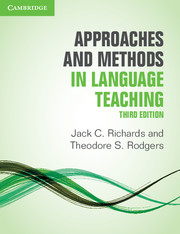Book contents
- Frontmatter
- Contents
- Acknowledgments
- Introduction to the third edition
- I Major trends in twentieth-century language teaching
- II Current approaches and methods
- III Alternative twentieth-century approaches and methods
- IV The teaching and learning environment
- Appendix: Comparison of approaches and methods
- Author index
- Subject index
6 - Content-Based Instruction and Content and Language Integrated Learning (CLIL)
Published online by Cambridge University Press: 08 April 2022
- Frontmatter
- Contents
- Acknowledgments
- Introduction to the third edition
- I Major trends in twentieth-century language teaching
- II Current approaches and methods
- III Alternative twentieth-century approaches and methods
- IV The teaching and learning environment
- Appendix: Comparison of approaches and methods
- Author index
- Subject index
Summary
Introduction
Content-Based Instruction (CBI) refers to an approach to second language teaching in which teaching is organized around the content or subject matter that students will acquire, such as history or social studies, rather than around a linguistic or other type of syllabus. Students thus learn language and content at the same time, each supporting the develop-ment of the other (Lyster 2007). While the term Content-Based Instruction has been com-monly used to describe programs of this kind, particularly in North America, in Europe a related approach is known as Content and Language Integrated Learning (CLIL). The two approaches differ slightly in focus, much in the way that Situational Language Teaching and the Audiolingual Method (one developed in Europe; one in the United States) differed in focus (see Chapters 3 and 4). Both CBI and CLIL are part of a growing trend in many parts of the world to use English as a medium of instruction (Graddol 2006). They have features in common, but they are not identical. CBI often involves a language teacher teaching through English, working with a content teacher to co-teach a course, or a content teacher designing and teaching a course for ESL learners. CLIL often involves a content teacher teaching content through a second or foreign language, as does CBI, but also may involve content from subjects being used in language classes. That is, the CLIL curriculum may originate in the language class, whereas CBI tends to have as its starting point the goals of a content class. CBI emerged somewhat organically, advocated by a number of academics and educators supported by an extensive literature extending over a considerable period of time but without official sanction. CLIL, on the other hand, was officially proposed in a European Commission policy paper in which member states were encouraged to develop “teaching in schools through the medium of more than one language” (EC 1976). The acronym “CLIL” has been widely circulated within member states of the European com-munity since 1994 and has become, by decree “the core instrument for achieving policy aims directed at creating a multilingual population in Europe” (Dalton-Puffer 2007: 1). And unlike CBI, CLIL not only aims at stimulating multilingualism of all citizens in the European community but also strives to “preserve the independence and health of local languages” (EURYDICE 2013).
Information
- Type
- Chapter
- Information
- Approaches and Methods in Language Teaching , pp. 116 - 138Publisher: Cambridge University PressPrint publication year: 2014
Accessibility standard: Unknown
Why this information is here
This section outlines the accessibility features of this content - including support for screen readers, full keyboard navigation and high-contrast display options. This may not be relevant for you.Accessibility Information
- 1
- Cited by
